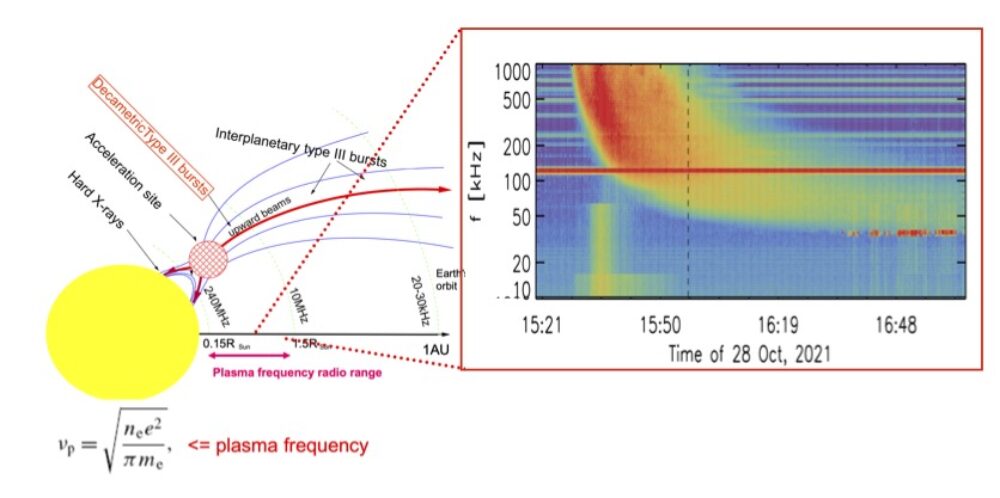Welcome on the team’s page !
Solar Type III radio bursts are amongst the strongest radio emissions within the Solar System. These intense radio signals are generated by energetic electrons, accelerated in the solar atmosphere and ejected to the interplanetary space. Similar radio emissions are supposed to be observed from the other stellar objects. However, the solar radio emissions are unique, because many characteristics such as fluxes of energetic particles, associated waves measured in situ and basic parameters of plasma where they are generated are known and measured only for these type III radio bursts. It is widely accepted that the process of generation of radio waves occurs in two steps.
First, the two-stream instability of an electron beam results in the growth of electrostatic (ES) Langmuir waves that later produce electromagnetic (EM) emission at the plasma frequency due to the scattering by plasma ions or to some nonlinear process while the coalescence of two Langmuir waves can produce the harmonic emission. Analysis of electric field measurements onboard satellites has led to the understanding of the important role of the density fluctuations on the beam plasma interaction and the waves’ generation.
Recently new advances in the experimental studies of waves in the source regions of Type III solar radio bursts have been achieved due to important improvements in the ability to record long time series of electric field data. These time series, recorded by the Wind, STEREO Parker Solar Probe and Solar Orbiter spacecraft, provide a rich collection of Langmuir and Z-mode waves’ signals for analysis. Recent theoretical studies, modelling and computer simulations of the beam-plasma interaction in randomly inhomogeneous plasmas also shows that they may strongly affect the beam plasma interaction, resulting in significant decrease of the wave activity, increase of the beam relaxation length and transfer of a significant part of the wave energy to energetic particles leading to the formation of a tail of energetic electrons. Another important advancement is related with the increase of the time and frequency resolution of instruments onboard satellites. It allowed to establish and observe the fine structure of the type III bursts spectra. This important characteristic is often present in many type III bursts in different frequency ranges, it is called striae. Theoretical modelling of aiming to explain this feature shows that its characteristics are also related to the density fluctuations in the corona and solar wind.
However, there remains several important open questions to be studied. The main ones are:
a) What are the most important spatial and temporal scales of the of the density fluctuations that determine the process of transformation of Langmuir/Slow Extraordinary waves into electromagnetic emissions and the temporal decay of it?
b) What are the characteristic spatio-temporal characteristics of the density fluctuations that determine the rising and decay phases of the spectral features of the radio bursts?
c) What is the relative role of the Langmuir and Slow Extraordinary waves in the generation of the radio emissions?
d) What are the main factors governing this transformation of Langmuir waves to Z-mode waves?
e) What is the relative role of the fundamental and harmonic emission in the observed dynamic spectra?
f) How can Z-mode waves change the efficiency of the electromagnetic waves’ generation?
g) How do similar processes operate at different distances from the Sun, and how does the beam plasma
interaction evolves with the distance from the Sun?
Our multidisciplinary team consists of specialists in data analysis, theorists and experts in computer simulations and is aimed at studying the set of open questions related to the Type III emissions generation. We will use data of Wind, STEREO, MMS and of the recently launched Parker Solar Probe and Solar Orbiter satellites, that may provide complementary information, as well as recent measurements by the LOFAR facility. Experimental data will also be compared with the results of modelling and computer simulations. Different analysis tools will be used to distinguish the presence and the characteristics of nonlinear processes from the presence of oppositely propagating waves. The strength of this multidisciplinary team lies in the wide spectrum of expertise of its members, all of whom have been studying solar radio bursts from different perspectives. This combination of expertise opens an opportunity to make an important progress in understanding of different observational features of the type III radio bursts. Combining theory, ground based radio observations and in situ measurements onboard satellites we will make the major progress in answering longstanding questions of one of the fundamental problems of the space plasma physics. The results of our studies will be published in the Review article summarizing studies and discoveries from very first observations of the radio bursts to very recent advances.

